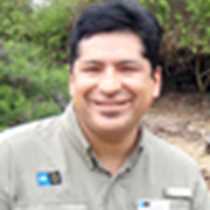Santiago Island
After navigating the whole night, leaving behind the western side of the archipelago, we started the day off with an early walk on Espumilla Beach. This paradisiacal location has many attractions: a wonderful long sea turtle nesting beach, a mangrove forest, a shallow lagoon and a fabulous view from up the little hill that crowns the trail filled with huge mature “Palo santo” trees (Bursera spp) all with the company of a fabulous choir of Darwin finches. Today we had a spectacular display of a couple of juvenile Galápagos Hawks (Buteo galapagoensis). The inquisitive birds were a delight to observe and photograph. For a long time these birds of prey were seen at a close range making us feeling that we were immersed in a nature movie production.
After coming back on board and during breakfast, our Captain repositioned the National Geographic Islander to Buccaneer Cove. This place was once a favorite location for pirates, buccaneers, and privateers, where they could find calm anchorages and provisions in the form of fresh water, firewood, and unfortunately plenty of tortoise meat. All those years of merciless exploitation are gone; nowadays Santiago Island is under the protection of the Galápagos National Park Service in order to preserve its ecosystems. For Lindblad Expeditions, Santiago Island is a very especial one for it was adopted by the company several years ago, providing funds to the Galápagos National Park Service that helped with the successful and total eradication of feral pigs and goats from the island.
Snorkeling and kayaking in Buccaneer Cove were excellent. Snorkelers spotted many colorful tropical fish, reef sharks, several rays and some Galápagos sea lions and Galápagos fur seals. Zodiac riders and kayakers explored the rocky coast and had a blast under the impressive tuff cliffs and into the shallow caves of the area. Many bird species like blue footed boobies, brown pelicans and noddy terns were seen everywhere. We were all back by noon after spending a busy but great morning!
After lunch I had the joy to give one of my favorite presentations: “Charles Darwin, a retrospective of the impact of Galápagos on his life and ideas.” Immediately after I finished at around 1530 we disembarked at Puerto Egas. We had a couple of options: a long and peaceful walk along the coastline or spending the whole afternoon swimming, snorkeling and/or relaxing at the black landing beach.
The walk follows an astonishing path nearby the ocean that is full of lava shores and crevices. Shore birds and Galápagos fur seals were highlights among the amazing amount and diversity of wildlife to see. Vibrant colored sally lightfoot crabs against the dark black lava, lava herons chasing them, invertebrates in the tidal pools, American oystercatchers, brown pelicans and Galápagos sea lions were seen her and there. As the day was coming to an end we returned to the ship with the company of the last sunrays of the day.




